|
Contemporaries in the Holy Roman Empire
Hohenzollern in Brandenburg
|
| The Zollern dynasty is named after their ancestral seat, Zolra Castle near Hechingen in present-day Baden-Württemberg. The name Hohenzollern was not used until the 16th century. The Zollern came to Franconia when the Hohenstaufen Emperor Henry VI (r.1190-1197) gave them the burgrave's office in Nuremberg in 1191/92. In 1214 the family divided into the Swabian and the Frankish line of the Zollern. The acquisition of the Mark Brandenburg in 1415/17 led to the formation of a further, Elector Brandenburg branch of the Zollern. |
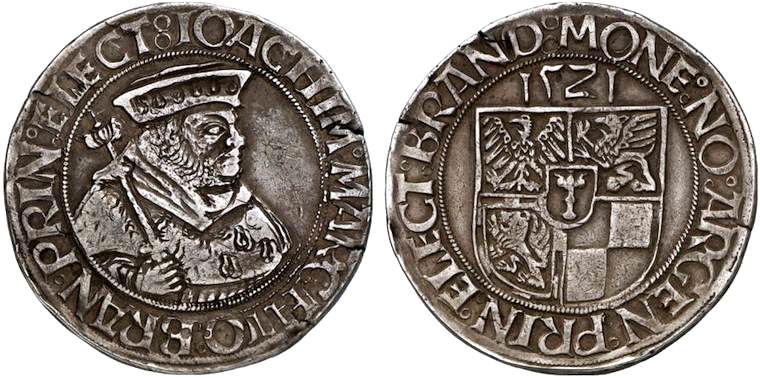
Guldengroschen 1521, Frankfurt/Oder. Ø 41 mm, 28,49 g. Bahrfeldt 294; Dav.8945. Obv.: ⦂IOACHIM⦂MARCHIO⦂BRANdenburgici⦂PRINceps⦂ELECTor : "Joachim, margrave of Brandenburg, elector"
Rev.: ⦂MONEta⦂NOva⦂ARGENtea⦂PRINcipis⦂ELECToris⦂BRANDenburgiciBust, crowned and in elector robes; the right hand holds the electoral sceptre. "Silver money from the electorate of Brandenburg"
Arms split in quarters (Brandenburg, Pomerania, Burgraveship of Nuremberg, Zollern) plus a center shield (imperial scepter of electoral Brandenburg), date on top.

1/4 Thaler 1524, Stendal. Ø 30 mm, 8,60 g. Bahrfeldt 308 h. Obv.: :IOAC·PRIN·ELEC·MAR·BRAND (mm.) Bearded bust in electoral robes, shouldering a scepter with his right hand. Rev.: MONE:NO:ARGEN:PRIN:ELECT:BRAND: Coat of arms as before, date 15Zጸ [1524].
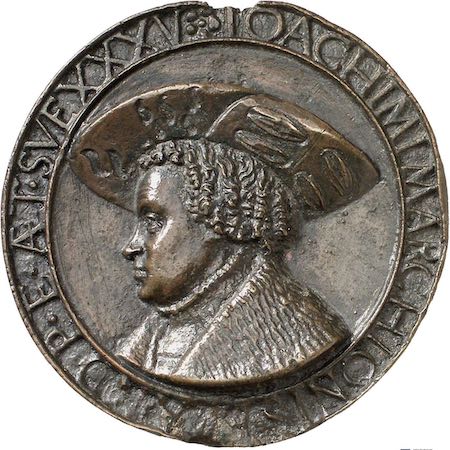
Uniface cast silver medal (about 1519) by Hans Schwarz. Ø 70 mm. Brockmann 2, Habich 143. Specimen in the Coin Cabinet from the Staatlichen Museen, Berlin 
IOACHIMI MARCHIONIS BRAND P·E ÆT·SVE XXXV❀ The age of 35 years correlates with the creation of the medal in 1519 and the ordering at the diet in Augsburg 1518.
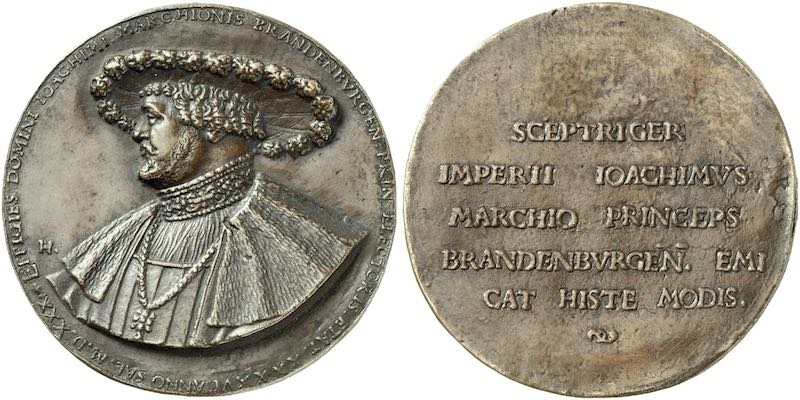
Cast bronze medal 1530. model by Friedrich Hagenauer. Ø 70,1 mm, 90,8 g. Brockmann 1, Habich 560. Obv.: EFFIGIES DOMINI IOACHIMI MARCHIONIS BRANDENBVRGENSIS PRIN ELECTORIS ETAT XXXXVI ANNO SAL M D XXX "The effigy of Lord Joachim, Margrave of Brandenburg, Elector, at the age of 46, in the year of salvation in 1530" Half-length portrait in feathered beret and coat with fur collar, and a necklace with jewel, to the left. In front of his shoulder the signature FH (as ligated monogram). Rev.: SCEPTRIGER / IMPERII IOACHIMVS / MARCHIO PRINCEPS / BRANDENBVRGEN. EMI / CAT HISTE MODIS "This is how Joachim, Margrave of Brandenburg, the bearer of the imperial scepter, looks like" Compare the painting 1529 |
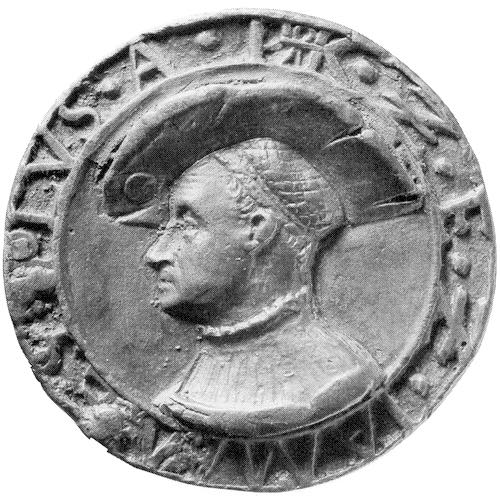
Single-sided cast medal n.d. (1518) by Hans Schwarz. Ø 55 mm. Habich I,1 131; Kastenholz 41. This only preserved specimen is kept in the Germanic National Museum in Nuremberg. P[?]K•Z•E•Z•IAM ME ... •PLVS•A• Bust to the left with net cat and beret, the brim with agraffe. A corresponding design drawing
 23x19cm has been preserved in the Staatl. Kupferstichkabinett Berlin. 23x19cm has been preserved in the Staatl. Kupferstichkabinett Berlin.
The 13-year-old Joachim had accompanied his father to the Imperial Diet in Augsburg in 1518. There Hans Schwarz made drawings that served as models for ordered medals.
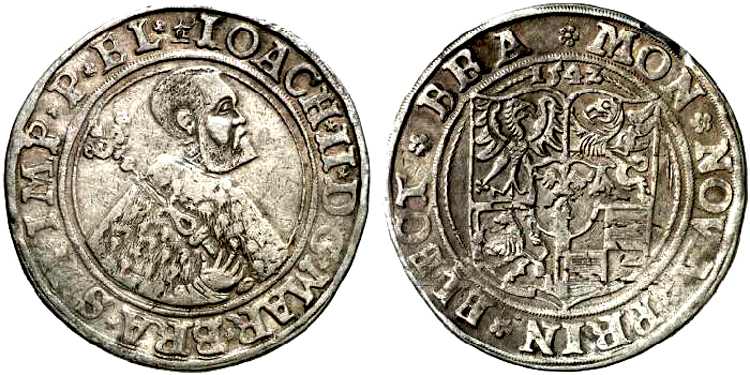
Guldengroschen 1542, Stendal. Ø 40 mm, 28,68 g. Bahrfeldt 348a; Dav.8950. Obv.: IOACHim·II·D·G·MARchio·BRAndenburgici·Sacri·Romini·IMPerii·Princeps·ELector· (mm. tower) "Joachim II, by the grace of God, Margrave of Brandenburg and Elector in the Holy Roman Empire" Bust with a sceptre on the right shoulder and in a coat of ermine. The tower at the end of the obverse legend is the "talking sign" of mint master Hans Thornow in Stendahl. Rev.: MONeta·NOVA·PRINceps·ELECToris·BRAndenburgici· coat of arms with center shield as before and date on top.
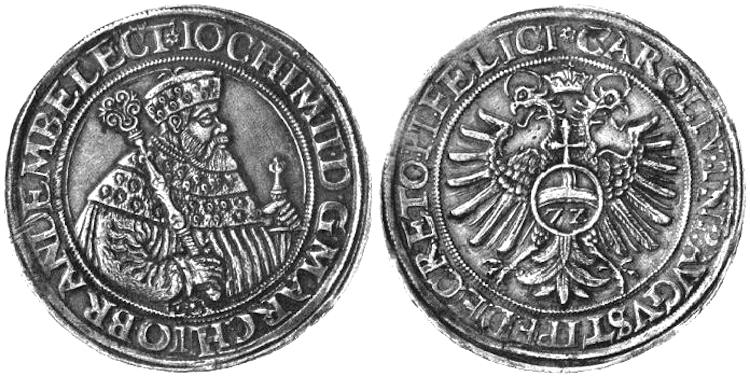
Reichsguldiner 1551, Berlin. Ø 42 mm, 30,74 g. Bahrfeldt 386; Dav.8951. Specimen from the Deutsche Bundesbank, Frankfort, published in Deutsche Taler (1966) pl.29. Obv.: IOCHIM·II·D·G·MARCHIO·BRANDEM·ELECT¤ (¤ = mint mark: mill wheel) Effigy in electoral robes, holding sceptre and sword, date 1551 below. Rev.: CAROLI·V·IN(m)Peratoris·AVGVSTI·Publicari Fecit·DECRETO·PIi·FELICIs¤ "Emperor Charles V, ever august, made by public decree"
crowned and haloed double eagle, the imperial orb with the value 72 (in Kreuzer) on its breast.
Look at the painting about 1570 
3 Gröscher 1553, Frankfurt Oder, for trade with Poland. Ø 20 mm Bahrfeldt 382c. Obv.: ¤IOACHim·Dei·Gratia·ELECTor:Princeps:BRANDenburgici·V Rev.: ¤III¤ | GrOSsus:ARGentea | TRIPlex:IOAChim | ELECTOR | BRA-ND | 15 (sceptre) 51 An imitation of the Polish denomination with its typical "head side" and "value side".

Ducat 1560, Berlin. Ø 22 mm, 3,43 g. Bahrf.- (455, as double ducat); Friedb.213.4 Obv.: IOACH᛭D᛭G᛭MARC᛭BRAN᛭ELEC - bareheaded bust in armor to the right. Rev.: ❀MONETA᛭NOVA᛭AVRE᛭BRAN᛭I560 quartered shield (Brandenburg, Pomerania, Burgraviate of Nuremberg, Zollern), in the center the imperial scepter of Electoral Brandenburg, a star above and to each side of the shield.
|
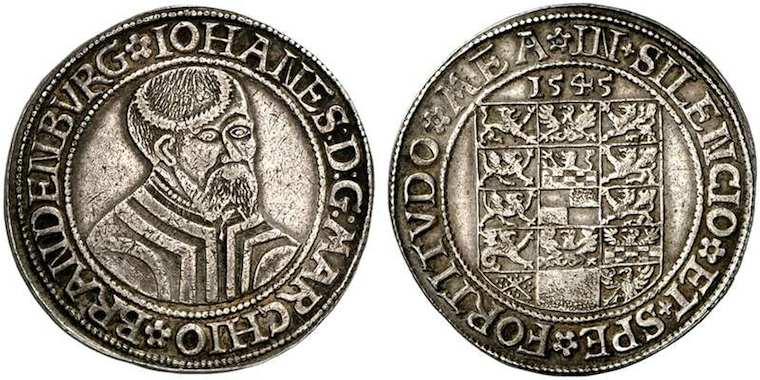
Thaler 1545, Krossen. Ø 42 mm, 29,08 g. Bahrfeldt 464; Dav.8956. Obv.: ¤IOHANNES:D:G:MARCHIO¤BRANDENBVRG "John, by the grace of God, Margrave of Brandenburg"
Rev.: ¤IN+SILENCIO¤ET+SPE¤FORTITVDO¤MEA "Silence and hope are my strenth."Compare with a detail of a picture about Christ's baptism von 1556 
Thaler 1545, Krossen. Ø 42 mm, 28,64 g. Bahrfeldt 465b; Dav.8957. Obv.: ❀IOHANES·D:G·MARCHIO❀BRANDENBVRG❀ armored bust to the right, the left hand on the sword hilt. Rev.: ❀IN᛭SILENCIO❀ET᛭SPE❀FORTITVDO❀MEA - shield with 15 fields, above the date +I545+.
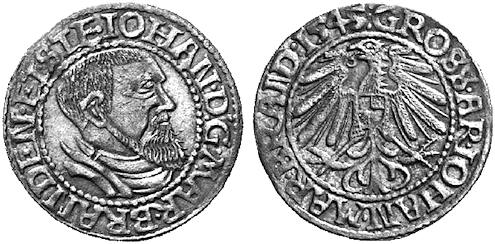
Groschen 1545, Krossen. Ø 22 mm, 1,95 g. Bahrfeldt 459a Obv.: +IOHAN·D:G·MARchio·BRANDEN·ET·STe ("STe..." for Stettin?) Rev.: GROSS·AR·IOHAN·MAR·BRAND:1545 Eagle with the arms of Hohenzollern on its breast. Compare with a Groschen 1543
 , from Königsberg, East Prussia. , from Königsberg, East Prussia.
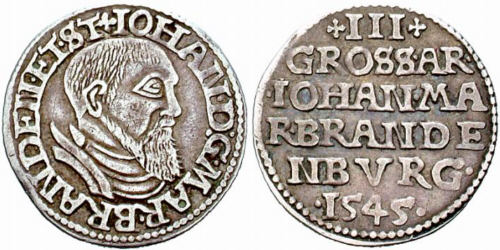
3 Gröscher 1545, Krossen. Ø 21 mm , Fr.u.S.1991 ; Bahrf.462 Obv.: +IOHAN·D:G·MAR·BRANDEN·ET·ST Rev.: +III+ | GROS·AR· | ·IOHAN·MA | R·BRANDE | NBVRG· | ·1545· Compare with a 3 Gröscher 1543
 from Königsberg, East Prussia. from Königsberg, East Prussia.
|

Gilded cast silver medal 1560, probably from the workshop of Hans Schenck. Ø 29 mm, 7,05 g. Brockmann 38; Habich II,1, 2266. Obv.: SIGIS.ARCHIEPIS MAGBEBVRG.MARCHIO BRAN.MDLX - Bust left with pot hat and feather. Rev.: Triple helmeted, 13 field coat of arms with the Magdeburg coat of arms as centre shield.
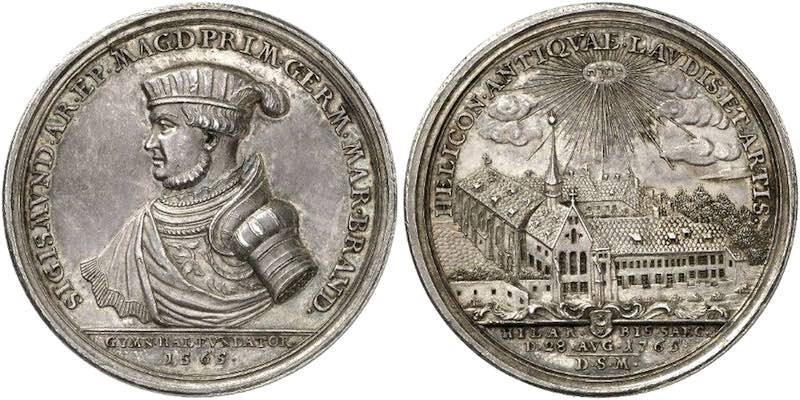
Silver medal 1765 by J.L.Oexlein, on the 200th anniversary of the Protestant grammar school in Halle. Ø 45 mm, 29,21 g. Marienb. 5046. Obv.: SIGISMVNDus·ARchi·EPiscopus·MAGDeburgensis PRIMas·GERManiae·MARchio·BRANDenbutgicus· Armoured bust with hat and folded over cloak. Exergue: GYMNasii.HALensis FVNDATOR / 1565. At the arm section: OEXLEIN. Rev.: HELICON·ANTIQVAE·LAVDIS·ET·ARTIS. Bird's eye view of the university building, Jehovah's name shining in the clouds above. In the exergue under the coat of arms of Halle: HILARia.BIS.SAECularia.Die.28.AVGusti.1765 / D.S.M. D.S.M. = David Samuel Madai ? |
|
other sovereigns of the Hohenzollern dynasty
Albert of Brandenburg, Archbishop of Magdeburg and Mayence 1514-1545
in Prussia: Albert, Grand Master of the Teutonic Order (1511-25) and Duke in Prussia (1525-68) in Franconia: Frederick II the Elder 1460-1536, Margrave of Brandenburg-Ansbach Casimir of Kulmbach 1481-1527, Margrave of Brandenburg-Kulmbach George the Pious 1484-1543, Margrave of Brandenburg-Ansbach 1515-1543 Frederick 1497-1536, Provost in Würzburg and Mayence Albert Alcibiades 1522-1557, Markgrave of Brandenburg-Kumbach George Frederick the Elder 1539-1603, Margrave in Franconia, Duke of Jägersdorf & Prussia |
 start page
start page